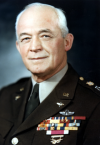President Theodore Roosevelt selected Brigadier General Henry M Arnold for promotion to Major General and to head the new Army Air Corp. General Arnold would eventually bring the Army Air Corp into a separate service as the United States Air Force in 1946.
